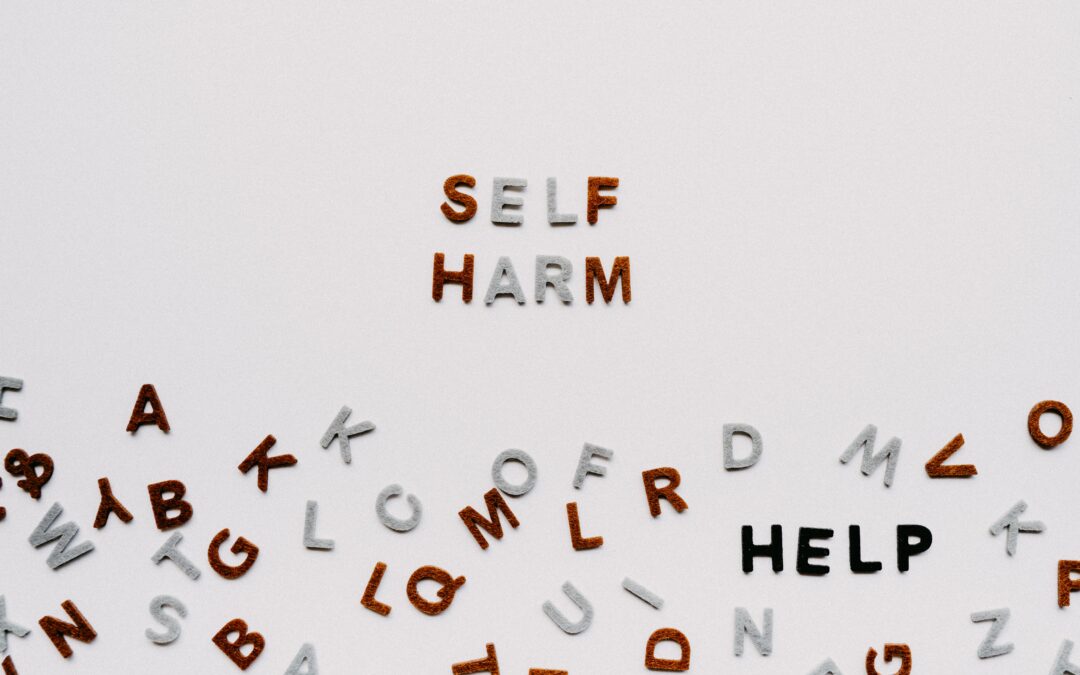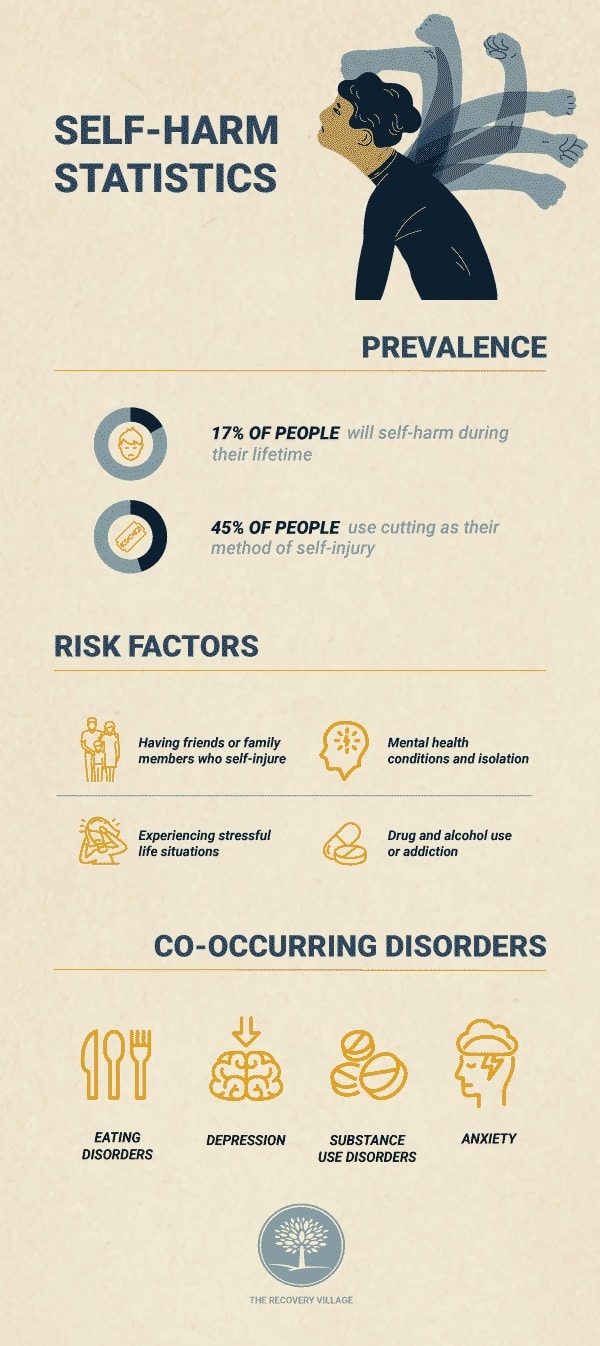People often keep it a secret, but the urge to self-harm isn’t uncommon, especially in adolescents and young adults. Many overcome it with treatment.
Whether a person has recently started hurting themself or has been doing it for a while, there is an opportunity to improve health and reduce behaviors. Talking to a mental health professional, a trusted friend, or family member is the first step towards understanding your behavior and finding relief.
Emotions, when they arise, affect the whole body, and if we’ve experienced traumas or adversity, emotions are incredibly overwhelming and harder to manage (especially when we feel alone with them). Our mind and body can block certain emotions with other emotions like anxiety, guilt, and shame. These complex and painful emotional cocktails can feel unbearable.
What Is Self-Harm?
Self-harm or self-injury means hurting yourself on purpose. One common method is cutting with a sharp object. But any time someone deliberately hurts themself is classified as self-harm. Some people feel an impulse to cause burns, pull out hair or pick at wounds to prevent healing. Extreme injuries can result in broken bones.
Hurting yourself—or thinking about hurting yourself—is a sign of emotional distress. These uncomfortable emotions may grow more intense if a person continues to use self-harm as a coping mechanism. Learning other ways to tolerate the mental pain will make you stronger in the long term.
Self-harm also causes feelings of shame. The scars caused by frequent cutting or burning can be permanent. Drinking alcohol or doing drugs while hurting yourself increases the risk of a more severe injury than intended. And it takes time and energy away from other things you value. Skipping classes to change bandages or avoiding social occasions to prevent people from seeing your scars is a sign that your habit is negatively affecting work and relationships.
Why People Self-Harm
Self-harm is not a mental illness, but a behavior that indicates a need for better coping skills. Several illnesses are associated with it, including borderline personality disorder, depression, eating disorders, anxiety, or post-traumatic distress disorder.
Self-harm occurs most often during the teenage and young adult years, though it can also happen later in life. Those at the most risk are people who have experienced trauma, neglect or abuse. For instance, if a person grew up in an unstable family, it might have become a coping mechanism. If a person binge drinks or uses illicit drugs, they are at greater risk of self-injury, because alcohol and drugs lower self-control.
The urge to hurt yourself may start with overwhelming anger, frustration, or pain. When a person is not sure how to deal with emotions, or learned as a child to hide emotions, self-harm may feel like a release. Sometimes, injuring yourself stimulates the body’s endorphins or pain-killing hormones, thus raising their mood. Or if a person doesn’t feel many emotions, they might cause themself pain to feel something “real” to replace emotional numbness.
Once a person injures themself, they may experience shame and guilt. If the shame leads to intense negative feelings, that person may hurt themself again. The behavior can thus become a dangerous cycle and a long-time habit. Some people even create rituals around it.
Self-harm isn’t the same as attempting suicide. However, it is a symptom of emotional pain that should be taken seriously. If someone is hurting themself, they may be at an increased risk of feeling suicidal. It’s important to find treatment for the underlying emotions.
Treatment And Coping
There are effective treatments for self-harm that can allow a person to feel in control again. Psychotherapy is important to any treatment plan. Self-harm may feel necessary to manage emotions, so a person will need to learn new coping mechanisms.
The first step in getting help is talking to a trusted adult, friend or medical professional who is familiar with the subject, ideally a psychiatrist. A psychiatrist will ask that person questions about their health, life history and any injurious behaviors in the past and present. This conversation, called a diagnostic interview, may last an hour or more.
Doctors can’t use blood tests or physical exams to diagnose mental illness, so they rely on detailed information from the individual. The more information that person can give, the better the treatment plan will be.
Depending on any underlying illness, a doctor may prescribe medication to help with difficult emotions. For someone with depression, for instance, an antidepressant may lessen harmful urges.
A doctor will also recommend therapy to help a person learn new behaviors if self-injury has become a habit. Several different kinds of therapy can help, depending on the diagnosis.
- Psychodynamic therapy focuses on exploring past experiences and emotions
- Cognitive behavioral therapy focuses on recognizing negative thought patterns and increasing coping skills
- Dialectical behavioral therapy can help a person learn positive coping methods
If your symptoms are overwhelming or severe, your doctor may recommend a short stay in a psychiatric hospital. A hospital offers a safe environment where you can focus your energy on treatment.
What To Do When Someone Self-Harms
Perhaps you have noticed a friend or family member with frequent bruises or bandages. If someone is wearing long sleeves and pants even in hot weather, they may be trying to hide injuries or scarring.
Keep in mind that this is a behavior that might be part of a larger condition and there may be additional signs of emotional distress. They might make statements that sound hopeless or worthless, have poor impulse control, or have difficulty getting along with others.
If you’re worried a family member or friend might be hurting themself, ask them how they’re doing and be prepared to listen to the answer, even if it makes you uncomfortable. This may be a hard subject to understand. One of the best things is to tell them that while you may not fully understand, you’ll be there to help. Don’t dismiss emotions or try to turn it into a joke.
Gently encourage someone to get treatment by stating that self-harm isn’t uncommon, and doctors and therapists can help. If possible, offer to help find treatment. But don’t go on the offensive and don’t try to make the person promise to stop, as it takes more than willpower to quit.
Raising awareness about self-harm is incredibly important. Awareness leads to understanding and empathy, banishing judgment and fear, and reducing the number of people who feel alone and suffer in silence. Raising awareness is about educating people who do not self-harm and reaching out to people who do.


